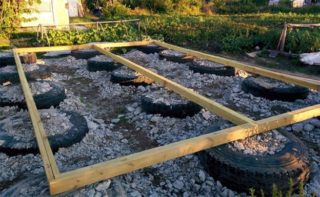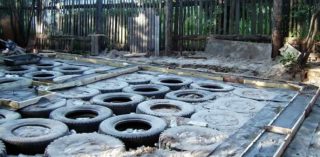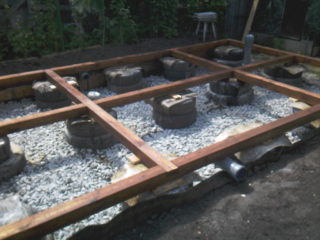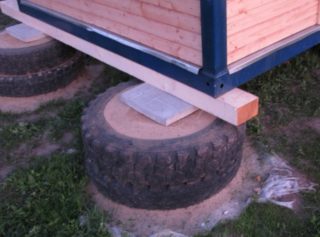Any real estate object, regardless of its size and purpose, needs a reliable, stable and durable foundation. When drawing up a project, each private developer tries to reduce costs and achieve the highest quality result. An excellent solution to this dilemma is a car tire foundation. The technology of its construction is not particularly complicated, but it has its own nuances that need to be paid attention to.
Scope of application of the tire foundation

As a rule, the owners of land plots are not limited to the construction of a residential building. For a normal and full-fledged existence on the site, many auxiliary structures are required, and for each you need to make a foundation. All this time and money, which is always in short supply. The decision to make a foundation from old tires can reduce inevitable costs by 40-50%.
The wheel foundation is great for the construction of such buildings:
- frame cottage;
- veranda;
- alcove;
- summer kitchen;
- barn;
- bath;
- garage;
- warehouse;
- workshop;
- open shower.
It is not recommended to make a foundation from tires for heavy objects. The safety margin of rubber is quite limited. Excessive savings can lead to irreparable consequences.
Varieties of tire foundation

To make the foundation for a bath from tires with your own hands, you can use one of the technologies, each of which has its own characteristics, pros and cons. When choosing, you should take into account the type of soil, terrain, groundwater level, weight and purpose of the structure. If we take into account all the nuances and carry out the correct calculations, the house on tires will stand for more than a decade without any complications.
Slab base
The slab foundation for a tire shed is a monolithic structure, where the wheels serve as a filler. Any building material with sufficient specific gravity is poured into the rubber products and tightly rammed. It can be granite screening, sand, gravel and even brick and concrete breakage, which remains quite a lot after construction and repair.
The advantage of this method is that the filler is distributed evenly over the volume of the base, while when the pit is poured, the stones go down, and cement mortar remains on the surface. The filled tires are enclosed with formwork and poured with concrete. This solution is effective when construction is carried out on quicksand or unstable clay soil. The load, evenly distributed over the area of the slab, prevents the building from sagging to one side.
Columnar base

Such a design is just a godsend for construction in lowlands and near water bodies where the water level changes. In addition, with the help of different heights of the pillars, it is possible to compensate for height differences on the site without labor-intensive and expensive earthworks. Tires are a free alternative to poles that are made from reinforced concrete, bricks or grout-filled pipes.
The technology is quite simple: the wheels are installed on top of each other and filled inside with solid bulk material. Subsequently, concrete is poured into the erected shaft. If this is not done, the fragments of the support will move to the sides under the influence of pressure from the side of the building.
Construction features

To correctly make a foundation from tires, it is necessary to take into account a number of features that are inherent in this technology. The decision to use free building material is not always the right one.
When arranging a base from old tires, remember the following points:
- It is better to use large wheels. They have thick walls, so they are stronger. The area of the products provides good adhesion and reduces the chance of slipping. Working in open spaces is much easier and more comfortable than in tight quarters.
- It is long and inconvenient to search on the side of the tire on your own. Plus, it is almost impossible to collect the right amount of the same size. It's easier to contact the service station. The staff will offer everything you need and deliver free of charge to reduce disposal costs.
- The base for the first layer of the foundation must be carefully leveled and tamped as tightly as possible. Even a slight slope can destroy the entire support system.
- The tire base does not need to be deeply immersed in the ground. Just a few centimeters is enough. Considering the shock-absorbing properties of rubber, it will absorb seasonal fluctuations in the ground.
- The black protectors that form the walls of the columns cannot in any way be a decoration of the site. There are many decor options, the simplest of which is acrylic paint.
For very light or temporary structures, it is not necessary to fill the shaft with concrete. It will retain its shape under the influence of gravity and friction between the wheels. In addition, after dismantling the structure, you will not need to think about how to get rid of a monolithic lump enclosed in rubber.
The sequence of work with your own hands
Even the simplest way to make a tire foundation requires careful preparation. It starts with drawing up a project and making calculations for the required property.
Tools and materials
To work you will need tools:
- shovel, hammer, ax, hacksaw;
- level, tape measure;
- Bulgarian;
- rammer;
- marker.
The need for a concrete mixer depends on the volume of mortar that will have to be made for pouring and the type of base. Columnar supports can be poured manually using a pallet or bucket with a mixer. To pour the slab foundation, you definitely need to purchase a concrete mixer.
You need to buy the following materials:
- geotextile fabric;
- formwork boards;
- cement;
- sand;
- crushed stone;
- paint;
- rope.
Construction should begin in the warm season, when the soil is completely dry and settles after the winter heaving.
Column foundation

The decision to create a support structure is made when construction is carried out on dense and stable ground, including on slight slopes. The pillars are installed at the corners of the building, as well as under its internal and external walls at intervals of 200 cm. If there is no fertile layer, installation can be carried out without first removing the soil. But this happens rarely, the summer resident still has to do earthwork.
The installation of the pillars should be carried out in the following sequence:
- Make a markup, check the correspondence of opposite sides and diagonals. Mark the places for the supports by driving stakes into the ground.
- Dig round pits, tamp their bottom, lay a geotextile lining.
- Backfill with sand and gravel, level and compact the pillow.
- Lower the wheels into the holes, give them a strictly horizontal position, operating with a level and a shovel.
- Make a mixture of rubble and sand, moisten it to fill the space inside the tires. Repeat the procedure until the desired height is reached.
- Make and pour concrete mortar inside the assembled mines. Remove air bubbles from it with a steel pin or an electric vibrator. Level the surface.
- Let the structure stand for 28 days to gain full strength.
To give the foundation additional strength and stability, you can combine all the supports into one structure using pile technology. To do this, before pouring the mortar, a mortgage is inserted into each shaft. It can be an iron pipe, channel or reinforcement frame. After hardening, the heads are leveled and connected with a grillage.
Slab foundation

Monolithic foundations are made with the expectation that they will serve throughout the entire design life of the building. These are monumental structures designed for high vertical loads.
Construction stages:
- Carry out a markup - apply a contour of the future foundation to the site in accordance with the previously drawn up diagram. It is necessary to provide a place for the installation of formwork or strapping.
- Excavate soil. The depth of the pit should be between 50-80 cm, depending on the height of the tires and the thickness of the cushion. Clear the bottom of the pit from stones, plant roots, level it and compact it thoroughly.
- Lay the geotextile fabric into the pit, fixing its edges. Add sand and gravel. Moisten, level and compact the backfill.
- Prepare the filler. It is a mixture of solid fragments and sand, which ensures that there are no voids. It is better if the fragments are as small as possible.
- Install the formwork. To facilitate its removal after the solution has hardened, attach cellophane, roofing felt or other similar material to the inner walls of the mold.
- Pour the mixture into the voids between the wheels and into their internal cavities. Tamp and level the surface well. Check the level of the surface with a level.
- Install a waterproofing layer. Make the joints of the strips with an overlay of 15-20 cm, and then glue them with tape.
- Make a lattice from reinforcement. Lay it on props 2-3 cm high.
- Mix the concrete mortar and pour it into the mold so that it covers the tires with a layer of 5-10 cm, depending on the expected load. Level the surface.
- After the concrete stops flowing, cover it with cellophane. After a day, start daily watering the plate with water to ensure it dries evenly.
Removal of the formwork can be done after a week, and the slab can be used after 28 days. Before further construction, the edges of the waterproofing are removed and glued to the side and top of the foundation.
Advantages and disadvantages of a tire foundation
The advantages of such structures:
- significant savings on materials, since they get 50-70% just for nothing;
- ensuring the elevation of the structure above the ground, due to which its cooling and the penetration of moisture into the interior is excluded;
- damping ground vibrations due to seismic activity or work carried out by a number of explosions or pile driving;
- resistance of the base to the effects of chemically active substances to which rubber is immune;
- high construction speed, as large fragments are used.
Bus foundations also have their disadvantages:
- decomposition of material under the influence of ultraviolet radiation - additional protection is required;
- the occurrence of an unpleasant odor when heated;
- insufficient strength for the construction of massive buildings.
To equip the base, use wheels with the maximum size and minimum wear, as this directly affects the strength of the finished structure.









